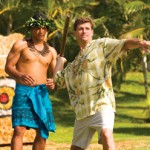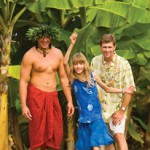Ever wonder what Hawaii residents of centuries past did for recreation and sport? Well, like everyone, they invented games that depended on readily available natural implements and demanded a high level of skill on the part of competitors.
Visitors of Paradise Cove have a chance to try their hand at several traditional Hawaiian games and learn firsthand that while each one may seem easy, looks can be deceiving.
The early Hawaiian people devoted a great amount of time to games, amusement, and relaxing pastimes. Some involved great physical strength, stamina, and danger. Some were reserved just for royalty. Many challenged the finer skills of dexterity, patience, and long practice, especially those that required carefully made game implements.
During the annual Makahiki, the festival season that lasted about four months from mid-October to mid-February, all unnecessary work ceased. After people paid their “taxes” to chiefs, generally in the form of handicrafts and garden products, they were then free to play and dance.
At Paradise Cove, You Can Participate In:
- ‘O’o ihe: Spear throwing. ‘O’o ihe, which once trained young warriors in hand-to-hand spear fighting and helped develop skills for food gathering, is frustratingly difficult. A target, sometimes the stalk of a banana plant, is set up. Contestants stand 15 feet away and attempt to stick a lightweight wooden spear into it. Kamehameha I was considered to be the most skillful chief in historic times in the use of the spear. An observer wrote of him, “.six spears were hurled at him at once; three he caught, two were parried and the sixth nimbly avoided by a trifling inclination of his body.”
- ‘Ulu maika: Rolling stone disks. ‘Ulu maika or ‘olohu was one of the most popular sports in early Hawai’i. It consisted of rolling carefully crafted playing stones, somewhat resembling modern hockey pucks, on specially prepared courses. The stones were rolled between stakes to test a player’s skills or rolled down long courses to show strength. One of the best of the remaining ‘ulu maika courses, approximately 500 feet long, is located on the island of Moloka’i.
- Moa pahe’e: Dart sliding. A player slides a moa, or wooden dart, between two stakes or for long distances much like the competition in ‘ulu maika. The moa slides, rather than rolling like an ‘ulu, and is much more unpredictable in its course.






